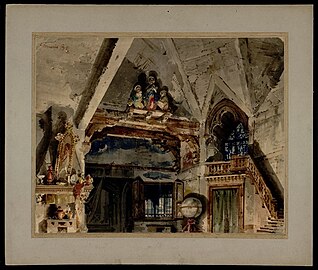
Carlo Ferrario (7 September 1833, Milan - 11 May 1907, Milan) was an Italian scenic designer, painter, and architect.
Biography
He was born to Giuseppe Ferrario, a blacksmith, and his wife Francesca née Basulli. While still a boy, he was forced to quit school and find work. One of his jobs was tending the shop for a local decorator. Already interested in the theater, this inspired him to copy the curtains and draperies he saw there. In 1852, he enrolled in the night courses at the Brera Academy, where he studied under the guidance of Enrico Robecchi (1827-1889). The following year, he was hired at La Scala, as an assistant to the stage manager.
In 1859 Luigi Bisi, professor of perspective at the academy, called him to serve as an adjunct there. He was named co-director at La Scala in 1867 and, the following year, became the Director of scenography. During this period he created curtains for several theaters in Milan. In 1878, he also provided stage settings for the opera Salvator Rosa, at the Teatro Argentina in Rome.
Due to disagreements with the theater's management company, over the necessity of a technical laboratory for designers, he left La Scala in 1881 and went to the Teatro Carcano. There, he worked without an assistant and often collaborated at other theaters, including the Teatro di San Carlo in Naples. He returned to La Scala in 1887, at the request of Giuseppe Verdi, who wanted him to produce the settings for Otello. This led to his reinstatement and a new laboratory. During the 1890s, he worked with Verdi on two more premieres, Falstaff and Rigoletto, as well as the Italian premieres of works by Wagner.
Approximately 600 drawings and sketches of his designs are preserved at the La Scala Museum. Many others may be found at the Casa Ricordi publishing house and in private collections, including the Donald Oenslager collection in New York.
In addition to his theater work, he painted landscapes and architectural interior scenes, in oil and watercolors. These included six panels for the new façade at Milan Cathedral. They were awarded the Canonica Prize in 1883. Together with Giuseppe Bertini, he decorated some rooms at the Turati Palace [it]. In 1882, he participated in the competition for a monument to Victor Emmanuel II, for which he was awarded a gold medal.
Selected works
-
 Don Carlos, Act I, Scene II
Don Carlos, Act I, Scene II
-
 Faust's Laboratory, Act I, Scene II, Mefistofele by Arrigo Boito
Faust's Laboratory, Act I, Scene II, Mefistofele by Arrigo Boito
-
 The City Palace in Brussels, for Il duca d'Alba,
The City Palace in Brussels, for Il duca d'Alba,
by Donizetti -
 Design for the ballet Don Parasol
Design for the ballet Don Parasol
-
 Otello, Act III
Otello, Act III
References
- ^ Biography of Ferrario by Amalia Pacia, from the Dizionario Biografico degli Italiani @ Treccani
- ^ Brief biography @ the Galleria Recta
Further reading
- Guido Marangoni, "Lo scenografo di Verdi. C. F.", in Emporium, XXXVIII (1913), pp. 285–309
- Valerio Mariani, Storia della scenografia italiano, Rinascimento del Libro, 1930, pp. 87, 89, 92
- Mario Monteverdi, "La scenografia", in Museo teatrale alla Scala, 1975, III, pp. 585–600
External links
![]() Media related to Carlo Ferrario at Wikimedia Commons
Media related to Carlo Ferrario at Wikimedia Commons